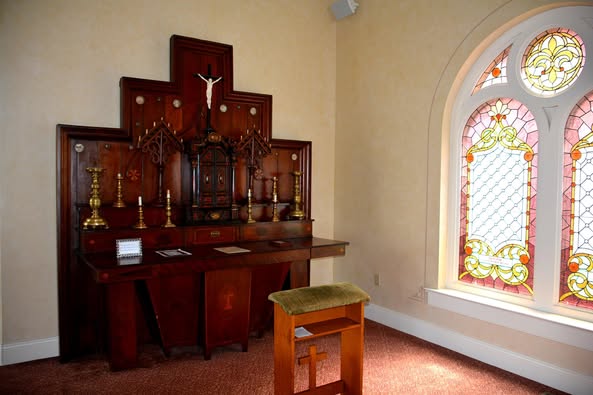

A Kentucky Altar with a Belgian Soul
Not every sacred site wears its history on its sleeve.
Sometimes, the oldest relics of faith are hidden in plain sight—quietly tucked into the heart of a working church, long past the days when their maker walked the earth. One such relic rests inside a historic Catholic church on Main Street in a small Kentucky town. It’s an altar—but not just any altar.
This one was carved, prayed over, and hand-assembled in 1807 by one of the most restless and devoted missionary priests the Kentucky frontier ever knew: Father Charles Nerinckx.
Before it found its final home here, this altar began its journey in the wilderness of Calvary, Kentucky—commissioned for a fledgling log church called Holy Mary, known today as Holy Name of Mary.
What follows is the story of a priest, a people, and the altar that brought them together in worship more than 200 years ago.
Origins of the 1807 Altar
The story begins in 1805. Father Charles Nerinckx, a Belgian priest in exile from Napoleonic Europe, had made his way to Kentucky. Here in the “Holy Land” of America—so-called for its dense population of Maryland Catholic settlers—he found both spiritual hunger and physical hardship.
That year, he laid the cornerstone for a modest log church near the Rolling Fork River. He called it Holy Mary. The people called it a miracle.
Built on donated land in Calvary, it was a sanctuary for scattered families who had been attending Mass in barns, homes, or not at all. There was no roof at first, no bell tower, no pews—and certainly no altar worthy of the Eucharist. But that would soon change.
In a letter written in 1807, Father Nerinckx shared his concern:
“Although we are not entirely without church furniture, our wants are great indeed; missals, crucifixes, statues, and pictures are most needed. Not one of our churches has what may be called an altar except Holy Cross; none has more than one chasuble; nor is a linen alb to be found in any of these which I did not furnish myself.”
With that conviction, he set about importing sacred goods—often through the help of friends in Europe—and contracting local craftsmen in Kentucky to fashion what could not be imported.
The altar was completed that same year and installed at Holy Mary: a quiet triumph of faith in the wilderness.
But to Father Nerinckx, it was never “just furniture.”
“Being constantly occupied in building churches and altars, I wish we could obtain books and pictures from Belgium, in order to give our workmen here some good models and sketches.”
Beauty, for him, was not indulgence. It was dignity in worship. It was soul work.
A Holistic Missionary
That same 1807 letter reveals more than just liturgical needs. Alongside requests for chalices and vestments, he also asked for:
“…seeds of different kinds of trees, shrubbery, and fruits… and more salves, with explanation of their virtues and directions for use.”
He wasn’t simply building churches. He was building communities. Rooted in prayer. Grounded in healing. Growing with hope. And always, he built altars.
The Altar’s Quiet Survival—and Its Final Home
As years passed and buildings were rebuilt or replaced, the altar was eventually moved from its original log home in Calvary.
But it was not forgotten.
Generations of Kentucky Catholics saw to it that this sacred object was preserved, restored, and ultimately reinstalled in another church—one equally grounded in early Catholic settlement.
The church that houses it now began construction in 1890, reflecting the growing needs of the parish. Romanesque in style, brick-built, and situated on Main Street, it stands today with little fanfare… except perhaps in its side chapel.
Because tucked away inside that chapel is the 1807 altar. Quiet. Weathered. Still doing its job.
Relics Above the Tabernacle
One of the most remarkable features of this altar is what lies above the tabernacle: sealed relics of Roman martyrs, embedded in keeping with ancient tradition.
These may be bone fragments, cloth, or hair from saints—many of whose names have been lost to time but not to the Church.
To early Kentucky Catholics, these relics weren’t mere objects. They were a direct connection to the underground churches of Rome—to the Masses whispered in the catacombs.
They made the frontier feel closer to Heaven.
Why It Matters
This altar isn’t just wood and marble. It’s a doorway.
A doorway to a time when Masses were whispered in candlelight. When priests crossed muddy rivers and stayed in strangers’ homes just to bring the sacraments. When churches didn’t yet have floors—but they had faith.
Father Charles Nerinckx could have stayed in Europe. He had status. He had education. He had comfort. But he chose mud, hunger, blisters, and bugs—and souls. He built fourteen churches, founded the Sisters of Loretto, and ministered to hundreds of families. And through all that… He built altars.
Want to See It?
The church is still open today. Mass is offered upon the 1807 altar every first Saturday of the month.
It is not a museum piece. It is a living altar—still doing what Father Nerinckx meant it to do.
And if you’re curious to see places like this—where stories aren’t just told, but felt—come along.
